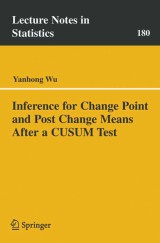Details

Inference for Change Point and Post Change Means After a CUSUM Test
Lecture Notes in Statistics, Band 180
|
53,49 € |
|
| Verlag: | Springer |
| Format: | |
| Veröffentl.: | 29.12.2007 |
| ISBN/EAN: | 9780387262697 |
| Sprache: | englisch |
| Anzahl Seiten: | 158 |
Dieses eBook enthält ein Wasserzeichen.
Beschreibungen
The change-point problem has attracted many statistical researchers and practitioners during the last few decades. Here, we only concentrate on the sequential change-point problem. Starting from the Shewhart chart with app- cations to quality control [see Shewhart (1931)], several monitoring procedures have been developed for a quick detection of change. The three most studied monitoring procedures are the CUSUM procedure [Page (1954)], the EWMA procedure [Roberts (1959)] and the Shiryayev?Roberts procedure [Shiryayev (1963) and Roberts (1966)]. Extensive studies have been conducted on the p- formancesofthesemonitoringproceduresandcomparisonsintermsofthedelay detection time. Lai (1995) made a review on the state of the art on these charts and proposed several possible generalizations in order to detect a change in the case of the unknown post-change parameter case. In particular, a wind- limited version of the generalized likelihood ratio testing procedure studied by Siegmund and Venkatraman (1993) is proposed for a more practical treatment even when the observations are correlated. In this work, our main emphasis is on the inference problem for the chan- point and the post-change parameters after a signal of change is made. More speci?cally, due to its convenient form and statistical properties, most d- cussions are concentrated on the CUSUM procedure. Our goal is to provide some quantitative evaluations on the statistical properties of estimators for the change-point and the post-change parameters.
CUSUM Procedure.- Change-Point Estimation.- Confidence Interval for Change-Point.- Inference for Post-Change Mean.- Estimation After False Signal.- Inference with Change in Variance.- Sequential Classification and Segmentation.- An Adaptive CUSUM Procedure.- Dependent Observation Case.- Other Methods and Remarks.
<P>This monograph is the first to systematically study the bias of estimators and construction of corrected confidence intervals for change-point and post-change parameters after a change is detected by using a CUSUM procedure. Researchers in change-point problems and sequential analysis, time series and dynamic systems, and statistical quality control will find that the methods and techniques are mostly new and can be extended to more general dynamic models where the structural and distributional parameters are monitored. Practitioners, who are interested in applications to quality control, dynamic systems, financial markets, clinical trials and other areas, will benefit from case studies based on data sets from river flow, accident interval, stock prices, and global warming. Readers with an elementary probability and statistics background and some knowledge of CUSUM procedures will be able to understand most results as the material is relatively self-contained. </P>
<P></P>
<P>The exponential family distribution is used as the basic model that includes changes in mean, variance, and hazard rate as special cases. There are fundamental differences between the sequential sampling plan and fixed sample size. Although the results are given under the CUSUM procedure, the methods and techniques discussed provide new approaches to deal with inference problems after sequential change-point detection, and they also contribute to the theoretical aspects of sequential analysis. Many results are of independent interests and can be used to study random walk related stochastic models. </P>
<P></P>
<P>Yanhong Wu is a visiting lecturer in statistics at the University of the Pacific. Previously, he was a visiting associate professor at the University of Michigan and an assistant professor at the University of Alberta. He has published more than forty research papers on the topics of change-point problem, quality control, mixture models, risk theory, and reliability mathematics.He was the receiver of Pierre-Robillard Award from the Canadian Statistical Society.</P>
<P></P>
<P> </P>
<P></P>
<P>The exponential family distribution is used as the basic model that includes changes in mean, variance, and hazard rate as special cases. There are fundamental differences between the sequential sampling plan and fixed sample size. Although the results are given under the CUSUM procedure, the methods and techniques discussed provide new approaches to deal with inference problems after sequential change-point detection, and they also contribute to the theoretical aspects of sequential analysis. Many results are of independent interests and can be used to study random walk related stochastic models. </P>
<P></P>
<P>Yanhong Wu is a visiting lecturer in statistics at the University of the Pacific. Previously, he was a visiting associate professor at the University of Michigan and an assistant professor at the University of Alberta. He has published more than forty research papers on the topics of change-point problem, quality control, mixture models, risk theory, and reliability mathematics.He was the receiver of Pierre-Robillard Award from the Canadian Statistical Society.</P>
<P></P>
<P> </P>
The main emphasis is on the inference problem for the change point and post-change parameters after a change has been detected More specifically, due to the convenient form and statistical properties, the author concentrates on the CUSUM procedure The goal is to provide some quantitative evaluations on the statistical properties of estimators on the change point and post-change parameters Includes supplementary material: sn.pub/extras

















